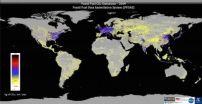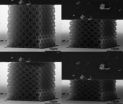(Press-News.org) Studies in mice demonstrate that signals from the bacteria that harmlessly—and often beneficially—inhabit the human gastrointestinal tract boost the immune system's ability to kill a major respiratory pathogen, Klebsiella pneumoniae, according to a paper published online ahead of print in the journal Infection and Immunity.
The research is yet another example of how important these "commensal" bacteria are to human health and physiology, says Thomas B. Clarke, of Imperial College London, UK, the lone author of this paper.
"Numerous studies have shown that changes in the composition of the bacterial groups which colonize our gastrointestinal tract are linked to numerous systemic diseases and conditions outside of the intestine," says Clarke, describing the rationale for this research. "What has often been missing is a mechanistic understanding of how these bacteria can actively shape the physiology of their host, and this is what I wanted to address. I was interested in finding out how commensal bacteria help protect us from infection by pathogenic bacteria."
"Alveolar macrophages are the lungs' first line of defense against bacterial infection," says Clarke. "I found that the production of reactive oxygen molecules by these cells was enhanced by these signals from the commensal bacteria."
Reactive oxygen molecules are highly toxic molecules produced by our immune systems to kill bacteria and help protect against infection, but they can also cause collateral damage to our tissues, says Clarke. This means their production must be tightly regulated, in order to kill bacteria without doing major damage to lung tissue.
"This work shows that signals from commensal bacteria are part of this regulation and help establish the appropriate level of immune activation," says Clarke.
Recent studies by others had shown that changes in the composition of the gut bacteria cause changes in the alveolar macrophages that boost allergic inflammation in the airway, indicating that alterations of the commensal bacteria could result in immune response gone awry.
In this study, Clarke gave mice antibiotics to kill most of the commensal bacteria in their gastrointestinal tracts. That, he found, reduced the ability of alveolar macrophages to kill K. pneumoniae, demonstrating that the commensal bacteria were somehow involved in this immune response.
In order to determine exactly what component of the commensal bacteria was needed to boost this immune response, Clarke gave the antibiotic-treated mice a series of different highly conserved compounds from bacteria, one at a time. He found that one particular compound, a major component of the bacterial cell wall, called peptidoglycan, boosted the immune response of these microbially-impoverished mice. Peptidoglycan is found in just about all bacteria, including commensals.
"Previously, it was generally considered that recognition of conserved bacterial components was a way for the immune system to detect the presence of pathogens. However, the work in this study is part of an emerging area of research that suggests that these bacterial molecules play an active role in constantly regulating immune function, even in the absence of infection," says Clarke.
INFORMATION:
The manuscript can be found online at http://bit.ly/asmtip0914c. The final version of the article is scheduled for the November 2014 issue of Infection and Immunity.
Infection and Immunity is a publication of the American Society for Microbiology (ASM). The ASM is the largest single life science society, composed of over 39,000 scientists and health professionals. Its mission is to advance the microbiological sciences as a vehicle for understanding life processes and to apply and communicate this knowledge for the improvement of health and environmental and economic well-being worldwide.
Commensal bacteria help orchestrate immune response in lung
2014-09-11
ELSE PRESS RELEASES FROM THIS DATE:
Researchers make scientific history with new cellular connection
2014-09-11
Researchers led by Dr. Helen McNeill at the Lunenfeld-Tanenbaum Research Institute have revealed an exciting and unusual biochemical connection. Their discovery has implications for diseases linked to mitochondria, which are the primary sources of energy production within our cells.
Dr. McNeill's team has an international reputation for their work in understanding how cells become organized into tissues and how growth is regulated during development. The group focuses on mutations in the fat (ft) gene. The protein product of this gene, called 'Fat', acts at the cell membrane ...
Primary care doctors reluctant to provide genetics assessment in routine care
2014-09-11
Ann Arbor, Mich. — Primary care providers report many challenges to integrating genetics services into routine primary care, according to research published today in Genetics in Medicine.
Medical genetics medicine has traditionally been used to identify and diagnose rare diseases, but in the last decade it has been increasingly helpful in determining patients at risk for genetically-based conditions who can benefit from preventive health care, says the study's senior author, Beth Tarini, M.D., M.S., F.A.A.P., assistant professor of pediatrics at the University of Michigan ...
Penn medicine study reveals profile of patients most likely to delay hospice enrollment
2014-09-11
One in six cancer patients enroll in hospice only during their last three days of life, according to a new study from a team from the Perelman School of Medicine at the University of Pennsylvania. Their findings, published online last month in the Journal of Clinical Oncology (JCO) also reveal a profile of patients who may be most at risk of these late admissions.
"Waiting until the final days of life to begin hospice can shortchange patients and their families – skipping over many benefits of hospice care and limiting the opportunity to improve patients' quality of ...
Study maps 15 years of carbon dioxide emissions on Earth
2014-09-11
TEMPE, Ariz. – World leaders face multiple barriers in their efforts to reach agreement on greenhouse gas emission policies. And, according to Arizona State University researchers, without globally consistent, independent emissions assessments, climate agreements will remain burdened by errors, self-reporting, and the inability to verify emissions progress.
Now, an international research team led by ASU scientists has developed a new approach to estimate CO2 emissions from burning fossil fuels — one that provides crucial information to policymakers. Called the "Fossil ...
Dartmouth research links genetic mutation and melanoma progression
2014-09-11
Dartmouth researchers have found that the genetic mutation BRAFV600E, frequently found in metastatic melanoma, not only secretes a protein that promotes the growth of melanoma tumor cells, but can also modify the network of normal cells around the tumor to support the disease's progression. Targeting this mutation with Vemurafenib reduces this interaction, and suggests possible new treatment options for melanoma therapy. They report on their findings in "BRAFV600E melanoma cells secrete factors that activate stromal fibroblasts and enhance tumourigenicity," which was recently ...
Ceramics don't have to be brittle
2014-09-11
Imagine a balloon that could float without using any lighter-than-air gas. Instead, it could simply have all of its air sucked out while maintaining its filled shape. Such a vacuum balloon, which could help ease the world's current shortage of helium, can only be made if a new material existed that was strong enough to sustain the pressure generated by forcing out all that air while still being lightweight and flexible.
Caltech materials scientist Julia Greer and her colleagues are on the path to developing such a material and many others that possess unheard-of combinations ...
Scientists report first semiaquatic dinosaur, Spinosaurus
2014-09-11
WASHINGTON (Sept. 11, 2014)—Scientists today unveiled what appears to be the first truly semiaquatic dinosaur, Spinosaurus aegyptiacus. New fossils of the massive Cretaceous-era predator reveal it adapted to life in the water some 95 million years ago, providing the most compelling evidence to date of a dinosaur able to live and hunt in an aquatic environment. The fossils also indicate that Spinosaurus was the largest known predatory dinosaur to roam the Earth, measuring more than 9 feet longer than the world's largest Tyrannosaurus rex specimen. These findings, published ...
Malaria parasites sense and react to mosquito presence to increase transmission
2014-09-11
Many pathogens are transmitted by insect bites. The abundance of vectors (as the transmitting insects are called) depends on seasonal and other environmental fluctuations. An article published on September 11thin PLOS Pathogens demonstrates that Plasmodium parasites react to mosquitoes biting their hosts, and that the parasite responses increase transmission to the mosquito vector.
Sylvain Gandon, from the CNRS in Montpellier, France, and colleagues first studied the theoretical evolution of parasite evolution in a variable environment. Using a mathematical model, they ...
Evolutionary tools improve prospects for sustainable development
2014-09-11
Solving societal challenges in food security, emerging diseases and biodiversity loss will require evolutionary thinking in order to be effective in the long run. Inattention to this will only lead to greater challenges such as short-lived medicines and agricultural treatments, problems that may ultimately hinder sustainable development, argues a new study published online today in Science Express, led by University of California, Davis and the Center for Macroecology, Evolution and Climate at the University of Copenhagen.
For the first time, scientists have reviewed ...
Dartmouth study may shed light on molecular mechanisms of birth defects among older women
2014-09-11
Dartmouth researchers studying cell division in fruit flies have discovered a pathway that may improve understanding of molecular mistakes that cause older women to have babies with Down syndrome.
The study shows for the first time that new protein linkages occur in immature egg cells after DNA replication and that these replacement linkages are essential for these cells to maintain meiotic cohesion for long periods.
The study appears in the journal PLOS Genetics. A PDF is available on request.
As women age, so do their eggs and during a woman's thirties, the chance ...



